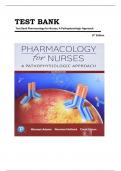TEST BANK
Test Bank Pharmacology for Nurses; A Pathophysiologic Approach
6th Edition
KA
G
U
A
,Pharmacology for Nurses, 6e (Adams)
Chapter 1 Introduction to Pharmacology
1) A nurse is reviewing key events in the history of pharmacology with a student nurse. Which
student comment indicates an understanding?
1. "Early researchers used themselves as test subjects."
2. "A primary goal of pharmacology is to prevent disease."
3. "Penicillin is one of the initial drugs isolated from a natural source."
4. "Pharmacologists began synthesizing drugs in the laboratory in the nineteenth century."
Answer: 1
Explanation:
1. Some early researchers, like Friedrich Serturner, used themselves as test subjects.
2. An early goal of pharmacology was to relieve human suffering.
3. Initial drugs isolated from complex mixtures included morphine, colchicine, curare, and
cocaine, but not penicillin.
4. By the twentieth century, pharmacologists could synthesize drugs in the laboratory.
KA
Page Ref: 3
Cognitive Level: Applying
Client Need/Sub: Physiological Integrity: Pharmacological and Parenteral Therapies
Standards: QSEN Competencies: I.A.1 Integrate understanding of multiple dimensions of
patient-centered care: patient/family/community preferences, values; coordination and
G
integration of care; information, co m muNnUi cRaStIi No nG,TaBn. Cd OeMd u cat ion ; physical comfort and
emotional support; involvement of family and friends; and transition and continuity. | AACN
Essential Competencies: I.7 Integrate the knowledge and methods of a variety of disciplines to
U
inform decision making. | NLN Competencies: Knowledge and Science: Integration of
knowledge from nursing and other disciplines. | Nursing/Integrated Concepts: Nursing Process:
Evaluation
A
Learning Outcome: 1-1 Identify key events in the history of pharmacology.
MNL Learning Outcome: 1.1 Examine the relationship between medicine and pharmacology.
,2) A student nurse asks a nursing instructor why anatomy and physiology as well as
microbiology are required courses when the student only wants to learn about
pharmacology. What is the best response by the instructor?
1. "Because pharmacology is an outgrowth of those subjects."
2. "You must learn all, since all of those subjects are part of the curriculum."
3. "Knowledge of all those subjects will prepare you to administer medication."
4. "An understanding of those subjects is essential to understand pharmacology."
Answer: 4
Explanation:
1. Pharmacology is an outgrowth of anatomy, physiology, and microbiology, but this is not
the most essential reason for the nurse to learn them.
2. The nurse must learn anatomy, physiology, and microbiology to understand
pharmacology, not because they are part of the curriculum.
3. Knowledge of anatomy, physiology, and microbiology prepares the nurse to understand
pharmacology, not to provide care such as administration of medications.
4. It is essential for the nurse to have a broad knowledge base of many sciences in order to
learn pharmacology.
KA
Page Ref: 3
Cognitive Level: Applying
Client Need/Sub: Physiological Integrity: Pharmacological and Parenteral Therapies
Standards: QSEN Competencies: I.A.1 Integrate understanding of multiple dimensions of
patient-centered care: patient/family/coNm munity preferences, values; coordination and
URSINGTB.COM
G
integration of care; information, communication, and education; physical comfort and
emotional support; involvement of family and friends; and transition and continuity. | AACN
Essential Competencies: I.7 Integrate the knowledge and methods of a variety of disciplines to
inform decision making. | NLN Competencies: Knowledge and Science: Integration of
U
knowledge from nursing and other disciplines. | Nursing/Integrated Concepts: Nursing Process:
Implementation
A
Learning Outcome: 1-2 Explain the interdisciplinary nature of pharmacology, giving an example
of how knowledge from different sciences impacts the nurse's role in drug administration.
MNL Learning Outcome: 1.1 Examine the relationship between medicine and pharmacology.
, 3) A nurse is teaching a group of nurses about the differences between pharmacology and
therapeutics. The nurse determines that learning has occurred when which statements are
made?
Note: Credit will be given only if all correct choices and no incorrect choices are selected. Select
all that apply.
1. "Pharmacology is the development of medicines."
2. "Pharmacology is the study of medicines."
3. "Therapeutics relates to drug use to treat suffering."
4. "Therapeutics is the study of drug interactions."
5. "Pharmacology is the study of drugs to prevent disease."
Answer: 2, 3, 5
Explanation:
1. Pharmacology is not the development of medicines.
2. Pharmacology is the study of medicines.
3. Therapeutics is the use of drugs in the treatment of suffering.
4. Therapeutics is not related to study of drug interactions.
5. Pharmacotherapy is the application of drugs for the purpose of disease prevention.
KA
Page Ref: 4
Cognitive Level: Applying
Client Need/Sub: Physiological Integrity: Pharmacological and Parenteral Therapies
Standards: QSEN Competencies: I.A.1 Integrate understanding of multiple dimensions of
patient-centered care: patient/family/coNm munity preferences, values; coordination and
URSINGTB.COM
G
integration of care; information, communication, and education; physical comfort and
emotional support; involvement of family and friends; and transition and continuity. | AACN
Essential Competencies: I.7 Integrate the knowledge and methods of a variety of disciplines to
U
inform decision making. | NLN Competencies: Knowledge and Science: Integration of
knowledge from nursing and other disciplines. | Nursing/Integrated Concepts: Nursing Process:
Evaluation
A
Learning Outcome: 1-3 Compare and contrast therapeutics and pharmacology.
MNL Learning Outcome: 1.1 Examine the relationship between medicine and pharmacology.




